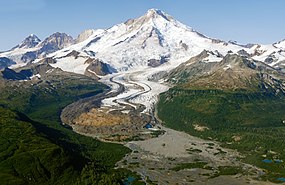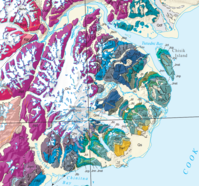Mount Iliamna
| Mount Iliamna | |
|---|---|
Tanaina) | |
| Geography | |
| Location | Lake Clark National Park and Preserve |
| Country | United States |
| State | Alaska |
| Region | Kenai Peninsula Borough |
| Parent range | Chigmit Mountains, Aleutian Range |
| Topo map | USGS Lake Clark A-1 |
| Geology | |
| Mountain type | Stratovolcano |
| Volcanic arc/belt | Aleutian Arc |
| Last eruption | 1876 |
| Climbing | |
| First ascent | 1959 |
| Designated | 1976 |
Iliamna Volcano, or Mount Iliamna (

The volcano's glaciers have extensively altered its profile, cutting, deep and creating steep cliffs and cirques.[5] A ridge extends 5 kilometres (3.1 mi) south from the main body of the mountain, with North Twin and South Twin peaks along its length. There is no summit crater, only a zone of fumaroles just south of the summit at the top of large collapse zone at the head of Red Glacier, which exposes a cross section of the mountain.[6]
Major glaciers radiate from the summit of Iliamna,[6] including Red Glacier, Tuxedni Glacier, Lateral Glacier and Umbrella Glacier.
Iliamna was first ascended in 1959.[2] It was designated a National Natural Landmark in 1976.[9]
See also
- Alaska Volcano Observatory
- List of mountain peaks of North America
- List of Ultras of the United States
- List of volcanoes in the United States
References
- ^ a b "Iliamna Volcano". Peakbagger.com. Retrieved 2019-02-10.
- ^ a b c "Iliamna Volcano". Bivouac.com. Retrieved 2019-02-10.
- ^ "Iliamna Volcano". Geographic Names Information System. United States Geological Survey, United States Department of the Interior. 1 January 2000.
- ^ Alaska Volcano Observatory, Volcano Information - Iliamna, Retrieved Dec. 16, 2022.
- ^ "Iliamna". Alaska Volcano Observatory. U.S. Geological Survey. Retrieved 10 February 2019.
- ^ a b "Iliamna: General Information". Global Volcanism Program. Smithsonian Institution. Retrieved 2021-06-28.
- ^ "Iliamna: Eruptive History". Global Volcanism Program. Smithsonian Institution. Retrieved 2021-06-28.
- ^ "2018 Update to the U.S. Geological Survey National Volcanic Threat Assessment" (PDF). U.S. Geological Survey. p. 20.
- ^ "Iliamna Volcano". National Natural Landmarks. National Park Service. Retrieved 10 February 2019.
External links
![]() This article incorporates public domain material from the United States Geological Survey
This article incorporates public domain material from the United States Geological Survey
- Iliamna Volcano at the National Park Service




